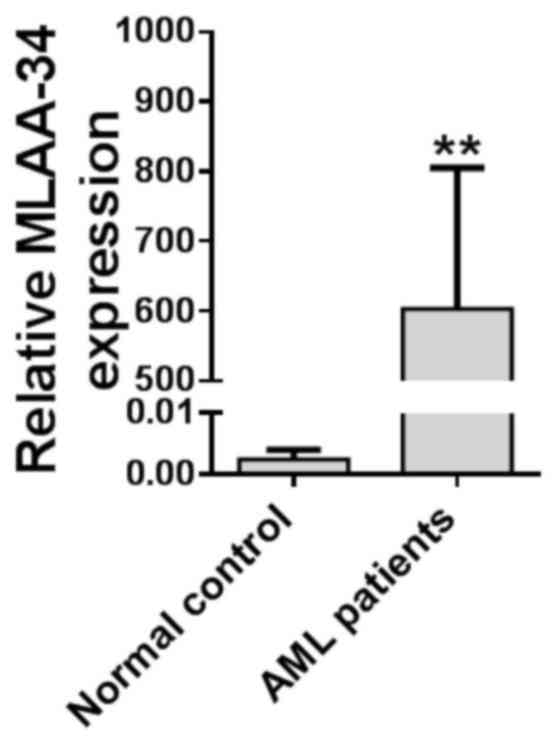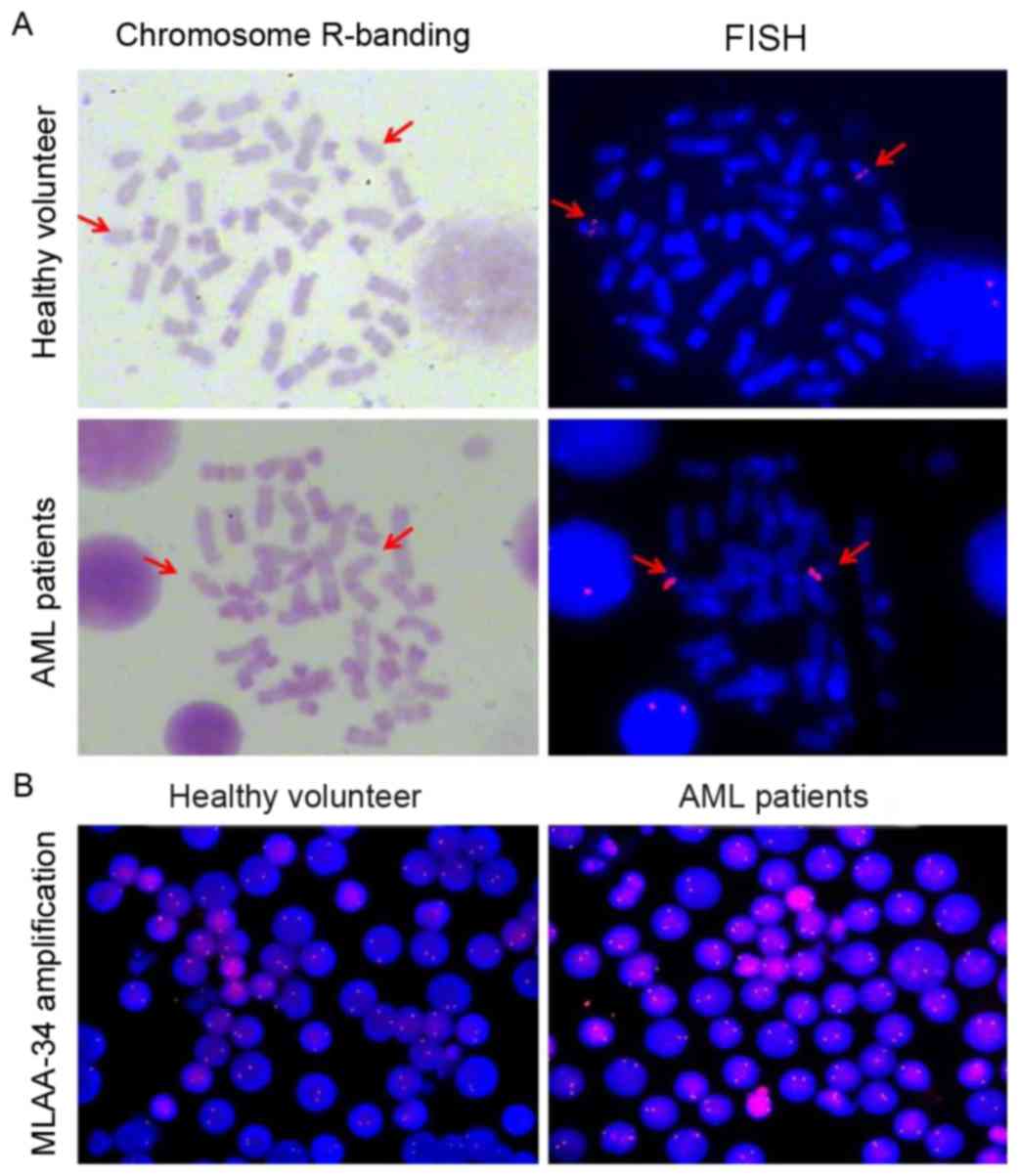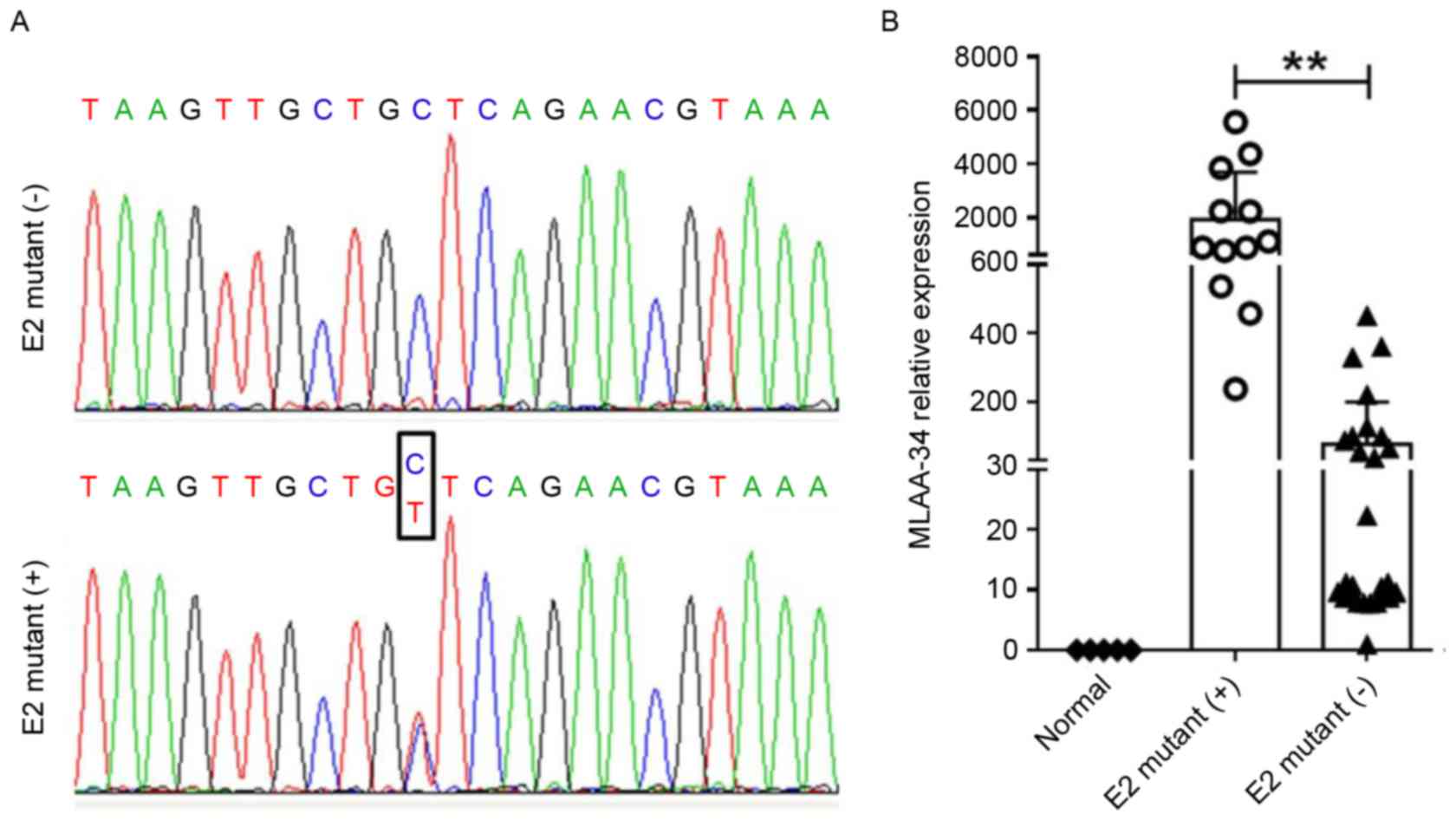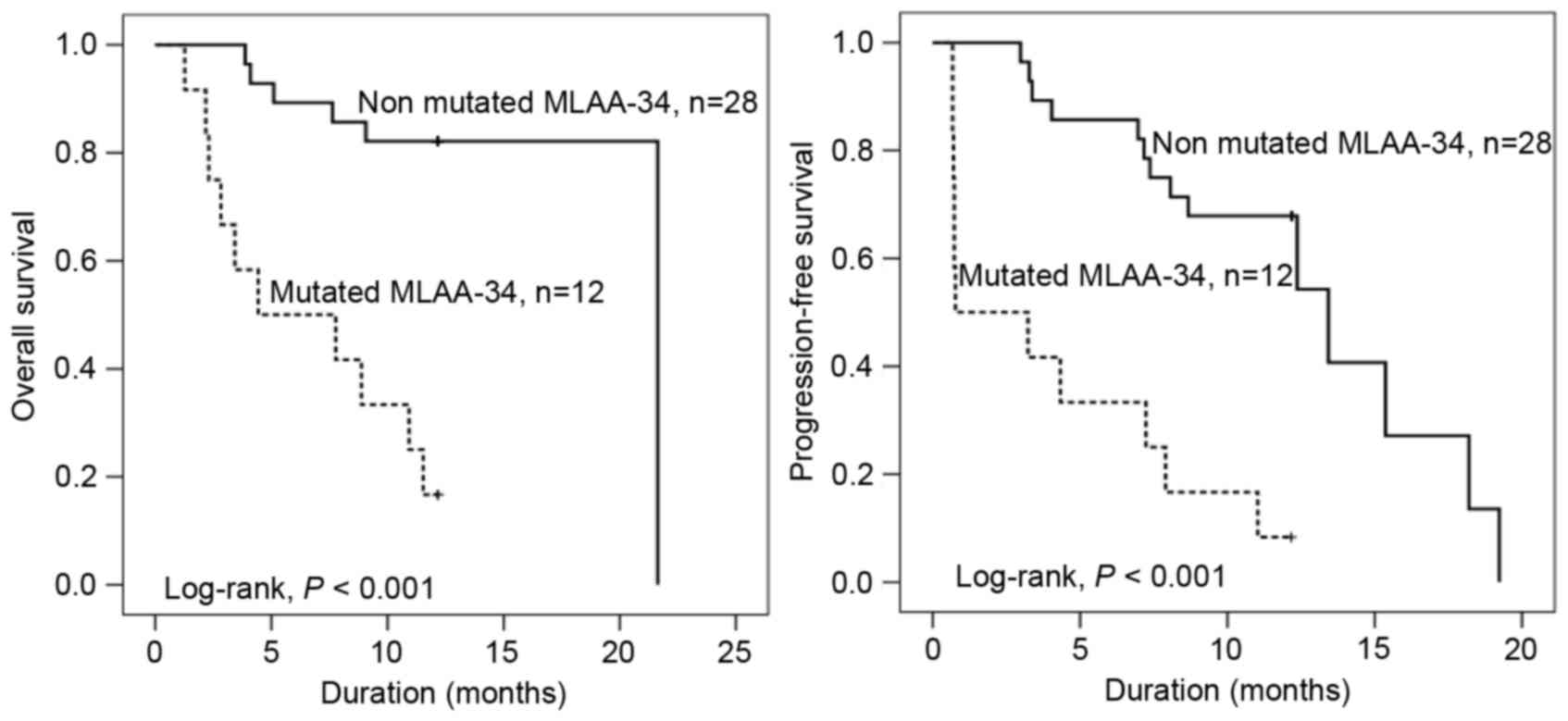|
1
|
Lindblad O, Chougule RA, Moharram SA,
Kabir NN, Sun J, Kazi JU and Rönnstrand L: The role of HOXB2 and
HOXB3 in acute myeloid leukemia. Biochem Biophys Res Commun.
467:742–747. 2015. View Article : Google Scholar : PubMed/NCBI
|
|
2
|
Stahnke B, Thepen T, Stöcker M, Rosinke R,
Jost E, Fischer R, Tur MK and Barth S: Granzyme B-H22(scFv), a
human immunotoxin targeting CD64 in acute myeloid leukemia of
monocytic subtypes. Mol Cancer Ther. 7:2924–2932. 2008. View Article : Google Scholar : PubMed/NCBI
|
|
3
|
Tettamanti S, Marin V, Pizzitola I,
Magnani CF, Attianese GM Giordano, Cribioli E, Maltese F,
Galimberti S, Lopez AF, Biondi A, et al: Targeting of acute myeloid
leukaemia by cytokine-induced killer cells redirected with a novel
CD123-specific chimeric antigen receptor. Br J haematol.
161:389–401. 2013. View Article : Google Scholar : PubMed/NCBI
|
|
4
|
Mensen A, Oh Y, Becker SC, Hemmati PG,
Jehn C, Westermann J, Szyska M, Göldner H, Dörken B, Scheibenbogen
C, et al: Apoptosis susceptibility prolongs the lack of memory B
cells in acute leukemic patients after allogeneic hematopoietic
stem cell transplantation. Biol Blood Marrow Transplant.
21:1895–1906. 2015. View Article : Google Scholar : PubMed/NCBI
|
|
5
|
Zhang PY, Zhang WG, He AL, Wang JL and Li
WB: Identification and functional characterization of the novel
acute monocytic leukemia associated antigen MLAA-34. Cancer Immunol
Immunother. 58:281–290. 2009. View Article : Google Scholar : PubMed/NCBI
|
|
6
|
Goswami M and Hourigan CS: Novel antigen
targets for immunotherapy of acute myeloid leukemia. Curr Drug
Targets. 18:296–303. 2017. View Article : Google Scholar : PubMed/NCBI
|
|
7
|
Sykes DB, Haynes MK, Waller A, Garcia M,
Urso U, Gouveia KE, Sklar L, Lewis TA, Dandapani S, Munoz B, et al:
Identifying small molecules that overcome differentiation arrest in
acute myeloid leukemia. Oncologist. 17:32012.PubMed/NCBI
|
|
8
|
Greiner J, Döhner H and Schmitt M: Cancer
vaccines for patients with acute myeloid leukemia-definition of
leukemia-associated antigens and current clinical protocols
targeting these antigens. Haematologica. 91:1653–1661.
2006.PubMed/NCBI
|
|
9
|
Zhao J, He A, Zhang W, Meng X and Gu L:
Quantitative assessment of MLAA-34 expression in diagnosis and
prognosis of acute monocytic leukemia. Cancer Immunol Immunother.
60:587–597. 2011. View Article : Google Scholar : PubMed/NCBI
|
|
10
|
Kottaridis PD, Gale RE, Frew ME, Harrison
G, Langabeer SE, Belton AA, Walker H, Wheatler K, Bowen DT, Burnett
AK, et al: The presence of a FLT3 internal tandem duplication in
patients with acute myeloid leukemia (AML) adds important
prognostic information to cytogenetic risk group and response to
the first cycle of chemotherapy: Analysis of 854 patients from the
United Kingdom Medical Research Council AML 10 and 12 trials.
Blood. 98:1752–1759. 2001. View Article : Google Scholar : PubMed/NCBI
|
|
11
|
Chen G, Zhang W, Cao X, Li F, Liu X and
Yao L: Serological identification of immunogenic antigens in acute
monocytic leukemia. Leuk Res. 29:503–509. 2005. View Article : Google Scholar : PubMed/NCBI
|
|
12
|
Zhang WJ, Zhang WG, Zhang PY, Cao XM, He
AL, Chen YX and Gu LF: The expression and functional
characterization associated with cell apoptosis and proteomic
analysis of the novel gene MLAA-34 in U937 cells. Oncol Rep.
29:491–506. 2013.PubMed/NCBI
|
|
13
|
Park IK, Mundy-Bosse B, Whitman SP, Zhang
X, Warner SL, Bearss DJ, Blum W, Marcucci G and Caligiuri MA:
Receptor tyrosine kinase Axl is required for resistance of leukemic
cells to FLT3-targeted therapy in acute myeloid leukemia. Leukemia.
29:2382–2389. 2015. View Article : Google Scholar : PubMed/NCBI
|
|
14
|
Park SH, Lee HJ, Kim IS, Kang JE, Lee EY,
Kim HJ, Kim YK, Won JH, Bang SM, Kim H, et al: Incidences and
prognostic impact of c-KIT, WT1, CEBPA, and CBL mutations, and
mutations associated with epigenetic modification in core binding
factor acute myeloid leukemia: A multicenter study in a Korean
population. Ann Lab Med. 35:288–297. 2015. View Article : Google Scholar : PubMed/NCBI
|
|
15
|
Sawyers CL: Finding the next Gleevec: FLT3
targeted kinase inhibitor therapy for acute myeloid leukemia.
Cancer Cell. 1:413–415. 2002. View Article : Google Scholar : PubMed/NCBI
|
|
16
|
Berenstein R, Blau IW, Suckert N, Baldus
C, Pezzutto A, Dörken B and Blau O: Quantitative detection of
DNMT3A R882H mutation in acute myeloid leukemia. J Exp Clin Cancer
Res. 34:552015. View Article : Google Scholar : PubMed/NCBI
|
|
17
|
Tawana K, Wang J, Renneville A, Bödör C,
Hills R, Loveday C, Savic A, van Delft FW, Treleaven J, Georgiades
P, et al: Disease evolution and outcomes in familial AML with
germline CEBPA mutations. Blood. 126:1214–1223. 2015. View Article : Google Scholar : PubMed/NCBI
|
|
18
|
Yoon JH, Kim HJ, Jeon YW, Lee SE, Cho BS,
Eom KS, Kim YJ, Lee S, Min CK, Cho SG, et al: Outcome of allogeneic
hematopoietic stem cell transplantation for cytogenetically normal
AML and identification of high-risk subgroup using WT1 expression
in association with NPM1 and FLT3-ITD mutations. Genes Chromosomes
Cancer; 2015
|
|
19
|
Fulton KM and Twine SM: Immunoproteomics:
Methods and protocols. Methods Mol Biol New York: Humana Press,
Springer; pp. 10612013
|
|
20
|
Yohe S: Molecular genetic markers in acute
myeloid leukemia. J Clin Med. 4:460–478. 2015. View Article : Google Scholar : PubMed/NCBI
|
|
21
|
Annesley CE and Brown P: Novel agents for
the treatment of childhood acute leukemia. Ther Adv Hematol.
6:61–79. 2015. View Article : Google Scholar : PubMed/NCBI
|
|
22
|
Chessells JM, Harrison CJ, Kempski H, Webb
DK, Wheatley K, Hann IM, Stevens RF, Harrison G and Gibson BE: MRC
Childhood Leukaemia working party: Clinical features, cytogenetics
and outcome in acute lymphoblastic and myeloid leukaemia of
infancy: Report from the MRC childhood leukaemia working party.
Leukemia. 16:776–784. 2002. View Article : Google Scholar : PubMed/NCBI
|
|
23
|
Bolkun L, Lemancewicz D, Jablonska E,
Szumowska A, Bolkun-Skornicka U, Ratajczak-Wrona W, Dzieciol J and
Kloczko J: The impact of TNF superfamily molecules on overall
survival in acute myeloid leukaemia: Correlation with biological
and clinical features. Ann Hematol. 94:35–43. 2015. View Article : Google Scholar : PubMed/NCBI
|
|
24
|
Qian L, Zhang W, Zhang P, Lei B, Wang X,
Wang M, Bai J and He A: The anti-apoptosis effect of MLAA-34 in
leukemia and the β-catenin/T cell factor 4 protein pathway. Am J
Transl Res. 7:2270–2278. 2015.PubMed/NCBI
|













